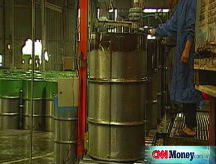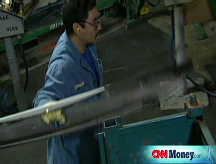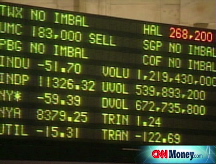Service sector remains in contraction
ISM index of non-manufacturing business shows that activity decreased in July, but not by as much as in June.
NEW YORK (CNNMoney.com) -- Business activity in the service sector contracted for the second straight month in July, although at a slower rate than in June, according to a key survey of industry executives released Tuesday.
The Institute for Supply Management's (ISM) non-manufacturing index rose to 49.5 from 48.2 in June. Economists were expecting a reading of 48.7, according to a consensus compiled by Briefing.com.
A reading above 50 indicates growth in the sector, and a reading below 50 means that the sector is contracting.
Still in contraction. Despite the rise, one analyst cautioned that the reading is still an indication of contraction in services.
"It is higher, no doubt about that, but the problem is that it is still below 50 and any measure below 50 is still in contraction," said Christian Menegatti, lead analyst with of RGE Monitor, an online economic research company.
"Saying things are better because the non-manufacturing index is at 49.5 rather than 48.2 is a little big far-fetched - it is a wrong interpretation of this economy right now," he said.
The service sector includes real estate, construction, mining, fishing, agriculture, health care, finance, insurance and administration.
"Members' comments in July indicate concern about inflationary pressures and the effect on the economy," said Anthony Nieves, chair of the ISM Non-Manufacturing survey committee in a written report.
The employment component increased to 47.1 from 43.8 in June, indicating contraction in the sector, but at a slower rate.
Menegatti said that even though the reading ticked up, it was still not a strong labor market reading.
The employment index "is improved but it is far from 50," he said. "I would be careful in seeing this as a significant improvement."
The reading on business activity for July decreased to 49.6 from 49.9 in June, a signal of slightly faster contraction.
The survey showed that demand for new orders also contracted faster in July, with the component slipping to 47.9 from 48.6 in June.
Prices increases for 62nd month in a row. Of particular concern for business owners, prices paid for materials and services by businesses increased in July for the 62nd consecutive month.
But the measure slipped to 80.8 from 84.5 in June.
The percentage of survey respondents reporting higher prices was 66%, while 30% indicated no change in prices. Only 4% of respondents reported lower prices.
Higher energy and commodity prices are hitting the service sector, but business owners are having a hard time passing on the higher costs to consumers, according to Menegatti.
"There is no way that businesses are not feeling the heat from high energy prices, especially since they are having a very hard time passing on these high costs to the consumer," he said. The consumer "is completely shopped out." ![]()




